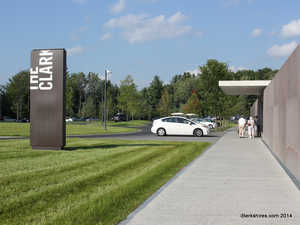Clark Art Opens Exhibition On Japanese Prints
WILLIAMSTOWN, Mass. — The Clark Art Institute presents a wide selection of works from its collection of Japanese prints.
"Competing Currents: 20th-Century Japanese Prints" includes more than thirty-five works and considers two specific movements that had an influence on twentieth-century printmaking in Japan. The exhibition is on view in the Clark's Eugene V. Thaw Gallery for Works on Paper from Nov. 6, 2021 through Jan. 30, 2022.
"We are eager to share a remarkable selection of works from our collection that we know our visitors will find both beautiful and fascinating," said Olivier Meslay, Hardymon Director of the Clark. "We are particularly proud to present this exhibition as it is the result of a valued partnership between the Clark and the Williams College Graduate Program in the History of Art. The curator of Competing Currents, Oliver Ruhl, developed the concept for and planned this exhibition during an internship at the Clark while he was a student in the graduate program. His impressive work is a tribute to Oliver's exceptional scholarship and curatorial creativity."
For more than two centuries during its Edo period (1603–1867) Japan witnessed a flowering of art and popular entertainment in its new capital, Edo (now Tokyo). The city's pleasure quarters were referred to as ukiyo (the floating world).
A new market of middle-class patrons encouraged artists to create images for mass distribution. The prints created to meet this demand were known as ukiyo-e (pictures of the floating world). Ukiyo-e, in the form of prints and posters, depicted hedonistic scenes from Edo's bars, brothels, and kabuki theaters.
Propelled by artists such as Kastushika Hokusai and Utagawa Hiroshige, landscape also became popular theme among patrons of ukiyo-e. The prints became popular not only in Japan, but eventually, across the globe as the country opened to international trade in the mid-nineteenth century.
By the beginning of the twentieth century, however, woodblock prints had largely fallen out of vogue. Japan's printmaking landscape underwent a shift with mass-market newspapers and magazines taking Japan by storm. The popular woodblock prints of the previous centuries suddenly seemed, to many, a relic of the past. During this transitional time in the early 1900s, two parallel printmaking movements rose to prominence—shin-hanga (new prints) and sōsaku-hanga (creative prints)—and reinvigorated the public's relationship with printmaking in both Japan and the West.
Shin-hanga was defined by a nostalgia for the premodern, while sōsaku-hanga embraced modernist and avant-garde sensibilities. In both movements, however, printmakers were forced to reckon with the legacy of ukiyo-e, new influences from European art, and the demands of a rapidly evolving global market. Simultaneously, a complete overhaul of Japan's public infrastructure, two world wars, and a series of natural disasters continually disrupted artistic pursuits.
Following differing politics and aesthetic ideals, twentieth-century Japanese printmakers responded to these events in varied ways, as seen in the heterogeneity of their compositions. Though shin-hanga and sōsaku-hanga represent only a small part of a complicated evolution, these works provide a glimpse of the contested artistic currents that defined Japanese printmaking in the twentieth century.
"Fundamentally, shin-hanga and sōsaku-hanga represented two radically different assertions of how Japanese printmaking should present itself on the widening world stage of the twentieth century," said exhibition curator Oliver Ruhl. "Drawing from the Clark's diverse collection of Japanese prints, this exhibition seeks to shed light on an often overlooked period of splendid artistic production."
Ruhl is a 2021 graduate of the Williams College Graduate Program in the History of Art. He developed the exhibition while completing an internship at the Clark with Anne Leonard, the Manton Curator of Prints, Drawings, and Photographs. He is currently a PhD candidate in the field of Japanese art history at The University of California, Los Angeles. In addition to his work at the Clark, Ruhl has held positions at The Museum of Fine Arts, Houston, the Cleveland Museum of Art, and the Williams College Museum of Art.
Traditional Japanese woodblock printing involved contributions from several individuals: a designer, a carver, a printer, and a publisher. Although only a single artist, usually the designer, took credit for a print, in both the ukiyo-e and shin-hanga movement works were a collaborative effort, with designers often having little control over how a woodblock was carved or printed.
Once the designer made a drawing, carvers attached it to the block and used knives and chisels to cut the design into the woodblock (traditionally cherry wood). After applying ink to the block, the printer would then press a sheet of paper against the block, using a tool called a baren, in order to transfer the design. Separate blocks were carved for every color in a print, with the most complicated prints requiring upwards of twenty separate woodblocks. The process of creating a woodblock, though laborious and time-consuming, allowed an image to be reproduced hundreds if not thousands of times before the block became unusable due to wear.
Tags: Clark Art,

